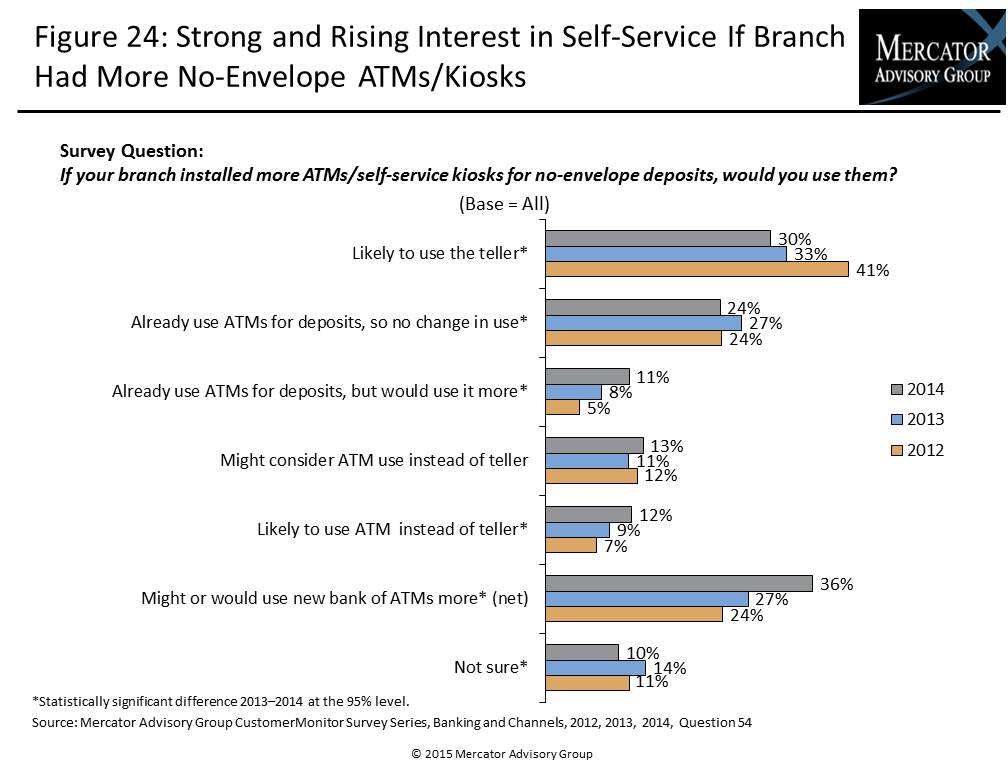Self-Service, ATM, and Other Channel Banking: Teller Displacement Begins
- Date:March 17, 2015
- Author(s):
- Karen Augustine
- Research Topic(s):
- North American PaymentsInsights
- PAID CONTENT
Overview
Mercator Advisory Group’s most recent Insight report from the bi-annual CustomerMonitor Survey Series, reveals that if consumers’ primary bank were to install more ATMs and self-service kiosks for no-envelope deposits, more consumers indicate they would be inclined to use the self-service method (36%) than would still only use the teller (30%). Since 2012, more consumers report they may take advantage of using an ATM instead of a teller (36% in 2014, up from 24% in 2012), while fewer consumers would still likely use a teller (30% in 2014, down from 41% in 2012). As self-service banking technology advances, becoming easier to use and offering greater functionality, consumers begin to prefer the convenience of self-service channels to conduct basic banking transactions rather than going to the branch to have a teller perform them.
Responses from an expanded sample of 3,000 U.S. adults were collected in the annual online Banking and Channels survey, conducted in November 2014. The survey finds the fastest growing check deposit method is mobile remote deposit. Despite a declining but overall preference for tellers, remote deposit capture is now the method preferred for check deposit rather than ATMs and bank tellers among young adults and smartphone and tablet owners for $50 checks. Tellers remain the preferred method for higher value, $1,000 checks, but consumer preference for teller deposits is declining. Moreover, nearly 1 in 10 consumers reported not having a check to deposit within the three months preceding the survey as nearly 1 in 3 consumers report their check use is declining.
Self-Service, ATM, and Other Channel Banking: Teller Displacement Begins, the latest report from Mercator Advisory Group’s Primary Data Service, highlights consumers’ rising use and interest in a wider variety of self-service and ATM channels, especially consumers who are most technically agile in using smartphones and tablets and mobile banking.
This study examines the demographic shift, changing preferences, and use of self-service channels compared to traditional branch banking and identifies trends in consumer methods of communicating with their bank and frequency of contact, methods, and preferences for getting cash and depositing checks; changes in use of cash and checks; use of ATMs by type and location; willingness to pay surcharges for convenience; importance of ATM characteristics in new bank selection; interest in using mobile cash access, self-service kiosks, and videoconferencing for discussions with banking specialists and separately for conducting bank transactions.
“This year’s Banking and Channels survey finds that teller displacement is clearly under way in the U.S.,” states Karen Augustine, manager of Primary Data Services including the CustomerMonitor Survey Series at Mercator Advisory Group and author of the report.
The report is 64 pages long and contains 27 exhibits.
Members of Mercator Advisory Group CustomerMonitor Survey Series Service have access to this report as well as the upcoming research for the year ahead, presentations, analyst access and other membership benefits.
One of the exhibits included in this report:

Highlights of this report include:
- Year-over-year trending of U.S. adult consumer use of self-service banking channels and frequency of use by each method
- Frequency and use of ATM deposits, envelope vs. no-envelope, cash vs. checks
- Demographics of preferred methods of depositing high- and low-value checks
- Shifts in methods of getting cash and depositing checks
- Change in use of cash and checks during the previous year
- Importance of ATM features and functionality in new bank selection
- Importance of enhanced functionality, payment services, and coupons and rewards offered at the ATM
- Trends in use of and interest in in-branch videoconferencing with product specialists or teller-assisted videoconferencing for conducting transactions
Book a Meeting with the Author
Related content
A Generational Look at Card Network Usage
In this Primary Data Snapshot by Javelin Strategy & Research, a dive into year-over-year usage of the four major U.S. credit card networks shows that generationally targeted approa...
The Bots are Coming: Generational Aspects to AI Adoption
This Primary Data Snapshot—a Javelin Strategy & Research report focusing on consumer payment usage and behavior—shows how consumers, particularly younger ones, are leveraging the p...
2025 North American PaymentInsights: U.S.: Financial Services and Emerging Technologies Exhibit
This report is based on Javelin Strategy’s North American PaymentsInsights series’ annual survey. A web-based survey was fielded between July 14 – 26, 2025, using a US online consu...
Make informed decisions in a digital financial world